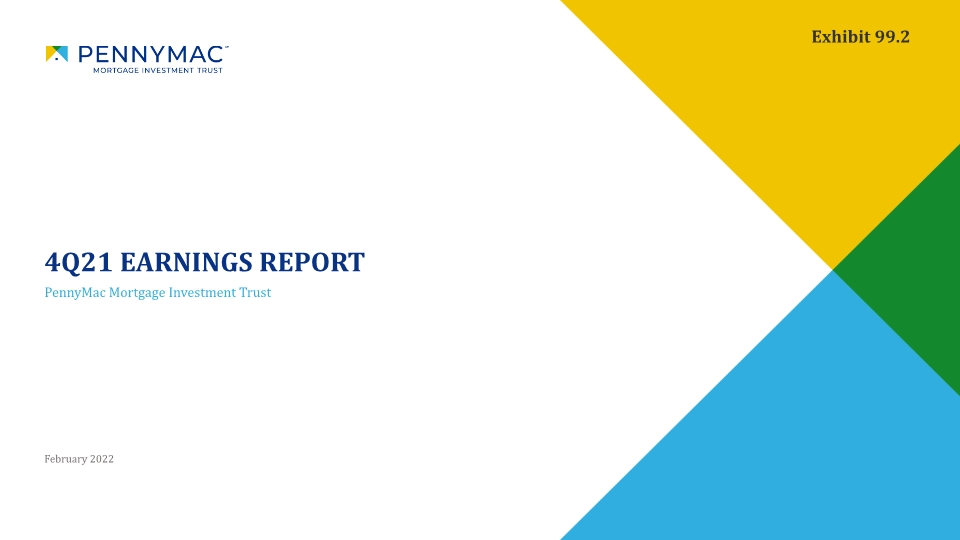
4Q21 EARNINGS REPORT PennyMac Mortgage Investment Trust February 2022 Exhibit 99.2
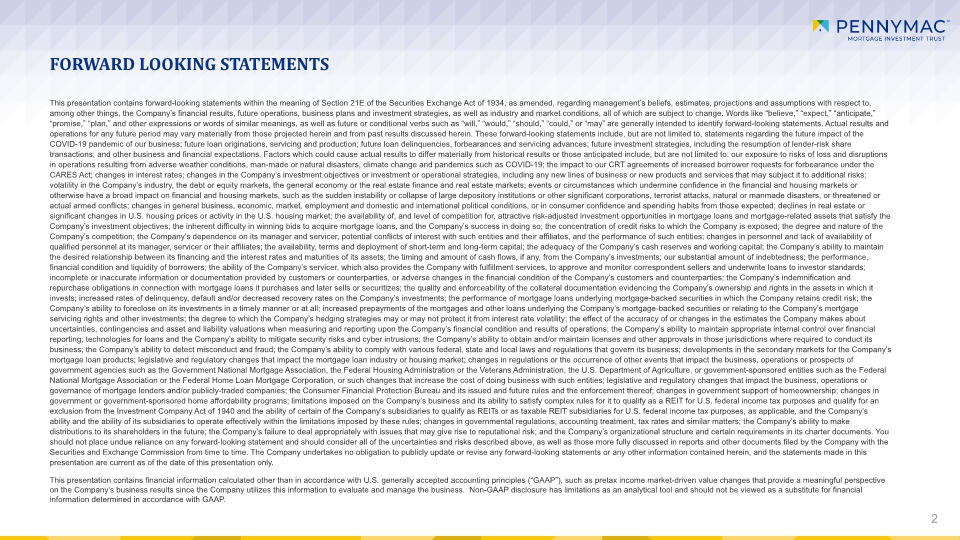
FORWARD LOOKING STATEMENTS 2 This presentation contains forward-looking statements within the meaning of Section 21E of the Securities Exchange Act of 1934, as amended, regarding management’s beliefs, estimates, projections and assumptions with respect to, among other things, the Company’s financial results, future operations, business plans and investment strategies, as well as industry and market conditions, all of which are subject to change. Words like “believe,” “expect,” “anticipate,” “promise,” “plan,” and other expressions or words of similar meanings, as well as future or conditional verbs such as “will,” “would,” “should,” “could,” or “may” are generally intended to identify forward-looking statements. Actual results and operations for any future period may vary materially from those projected herein and from past results discussed herein. These forward-looking statements include, but are not limited to, statements regarding the future impact of the COVID-19 pandemic of our business; future loan originations, servicing and production; future loan delinquencies, forbearances and servicing advances; future investment strategies, including the resumption of lender-risk share transactions; and other business and financial expectations. Factors which could cause actual results to differ materially from historical results or those anticipated include, but are not limited to: our exposure to risks of loss and disruptions in operations resulting from adverse weather conditions, man-made or natural disasters, climate change and pandemics such as COVID-19; the impact to our CRT agreements of increased borrower requests for forbearance under the CARES Act; changes in interest rates; changes in the Company’s investment objectives or investment or operational strategies, including any new lines of business or new products and services that may subject it to additional risks; volatility in the Company’s industry, the debt or equity markets, the general economy or the real estate finance and real estate markets; events or circumstances which undermine confidence in the financial and housing markets or otherwise have a broad impact on financial and housing markets, such as the sudden instability or collapse of large depository institutions or other significant corporations, terrorist attacks, natural or manmade disasters, or threatened or actual armed conflicts; changes in general business, economic, market, employment and domestic and international political conditions, or in consumer confidence and spending habits from those expected; declines in real estate or significant changes in U.S. housing prices or activity in the U.S. housing market; the availability of, and level of competition for, attractive risk-adjusted investment opportunities in mortgage loans and mortgage-related assets that satisfy the Company’s investment objectives; the inherent difficulty in winning bids to acquire mortgage loans, and the Company’s success in doing so; the concentration of credit risks to which the Company is exposed; the degree and nature of the Company’s competition; the Company’s dependence on its manager and servicer, potential conflicts of interest with such entities and their affiliates, and the performance of such entities; changes in personnel and lack of availability of qualified personnel at its manager, servicer or their affiliates; the availability, terms and deployment of short-term and long-term capital; the adequacy of the Company’s cash reserves and working capital; the Company’s ability to maintain the desired relationship between its financing and the interest rates and maturities of its assets; the timing and amount of cash flows, if any, from the Company’s investments; our substantial amount of indebtedness; the performance, financial condition and liquidity of borrowers; the ability of the Company’s servicer, which also provides the Company with fulfillment services, to approve and monitor correspondent sellers and underwrite loans to investor standards; incomplete or inaccurate information or documentation provided by customers or counterparties, or adverse changes in the financial condition of the Company’s customers and counterparties; the Company’s indemnification and repurchase obligations in connection with mortgage loans it purchases and later sells or securitizes; the quality and enforceability of the collateral documentation evidencing the Company’s ownership and rights in the assets in which it invests; increased rates of delinquency, default and/or decreased recovery rates on the Company’s investments; the performance of mortgage loans underlying mortgage-backed securities in which the Company retains credit risk; the Company’s ability to foreclose on its investments in a timely manner or at all; increased prepayments of the mortgages and other loans underlying the Company’s mortgage-backed securities or relating to the Company’s mortgage servicing rights and other investments; the degree to which the Company’s hedging strategies may or may not protect it from interest rate volatility; the effect of the accuracy of or changes in the estimates the Company makes about uncertainties, contingencies and asset and liability valuations when measuring and reporting upon the Company’s financial condition and results of operations; the Company’s ability to maintain appropriate internal control over financial reporting; technologies for loans and the Company’s ability to mitigate security risks and cyber intrusions; the Company’s ability to obtain and/or maintain licenses and other approvals in those jurisdictions where required to conduct its business; the Company’s ability to detect misconduct and fraud; the Company’s ability to comply with various federal, state and local laws and regulations that govern its business; developments in the secondary markets for the Company’s mortgage loan products; legislative and regulatory changes that impact the mortgage loan industry or housing market; changes in regulations or the occurrence of other events that impact the business, operations or prospects of government agencies such as the Government National Mortgage Association, the Federal Housing Administration or the Veterans Administration, the U.S. Department of Agriculture, or government-sponsored entities such as the Federal National Mortgage Association or the Federal Home Loan Mortgage Corporation, or such changes that increase the cost of doing business with such entities; legislative and regulatory changes that impact the business, operations or governance of mortgage lenders and/or publicly-traded companies; the Consumer Financial Protection Bureau and its issued and future rules and the enforcement thereof; changes in government support of homeownership; changes in government or government-sponsored home affordability programs; limitations imposed on the Company’s business and its ability to satisfy complex rules for it to qualify as a REIT for U.S. federal income tax purposes and qualify for an exclusion from the Investment Company Act of 1940 and the ability of certain of the Company’s subsidiaries to qualify as REITs or as taxable REIT subsidiaries for U.S. federal income tax purposes, as applicable, and the Company’s ability and the ability of its subsidiaries to operate effectively within the limitations imposed by these rules; changes in governmental regulations, accounting treatment, tax rates and similar matters; the Company’s ability to make distributions to its shareholders in the future; the Company’s failure to deal appropriately with issues that may give rise to reputational risk; and the Company’s organizational structure and certain requirements in its charter documents. You should not place undue reliance on any forward-looking statement and should consider all of the uncertainties and risks described above, as well as those more fully discussed in reports and other documents filed by the Company with the Securities and Exchange Commission from time to time. The Company undertakes no obligation to publicly update or revise any forward-looking statements or any other information contained herein, and the statements made in this presentation are current as of the date of this presentation only. This presentation contains financial information calculated other than in accordance with U.S. generally accepted accounting principles (“GAAP”), such as pretax income market-driven value changes that provide a meaningful perspective on the Company’s business results since the Company utilizes this information to evaluate and manage the business. Non-GAAP disclosure has limitations as an analytical tool and should not be viewed as a substitute for financial information determined in accordance with GAAP.
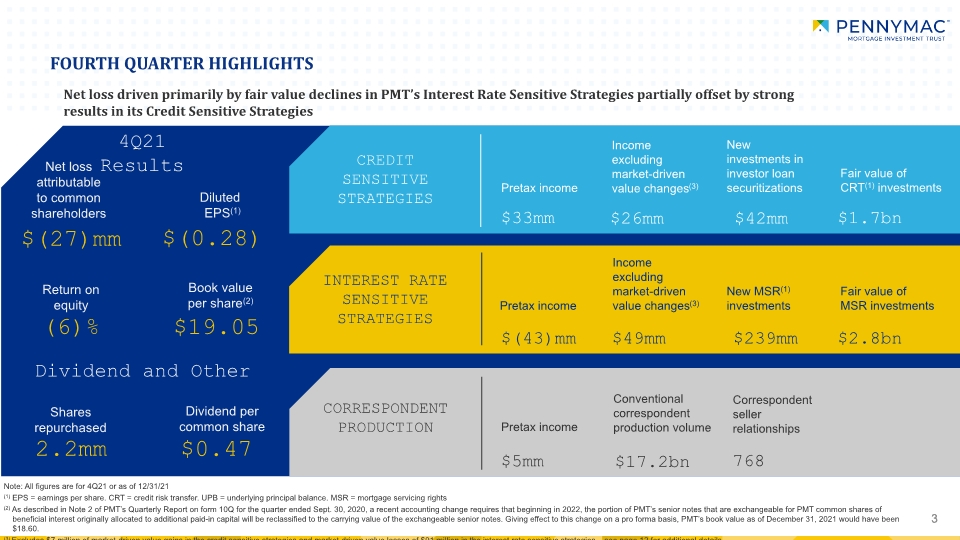
3 Note: All figures are for 4Q21 or as of 12/31/21 (1) EPS = earnings per share. CRT = credit risk transfer. UPB = underlying principal balance. MSR = mortgage servicing rights (2) As described in Note 2 of PMT’s Quarterly Report on form 10Q for the quarter ended Sept. 30, 2020, a recent accounting change requires that beginning in 2022, the portion of PMT’s senior notes that are exchangeable for PMT common shares of beneficial interest originally allocated to additional paid-in capital will be reclassified to the carrying value of the exchangeable senior notes. Giving effect to this change on a pro forma basis, PMT’s book value as of December 31, 2021 would have been $18.60. (3) Excludes $7 million of market-driven value gains in the credit sensitive strategies and market-driven value losses of $91 million in the interest rate sensitive strategies – see page 12 for additional details 3 FOURTH QUARTER HIGHLIGHTS Net loss attributable to common shareholders $(27)mm 4Q21 Results Diluted EPS(1) $(0.28) Return on equity (6)% Book value per share(2) $19.05 Dividend and Other Shares repurchased 2.2mm Dividend per common share $0.47 CREDIT SENSITIVE STRATEGIES INTEREST RATE SENSITIVE STRATEGIES CORRESPONDENT PRODUCTION Pretax income $33mm Pretax income $5mm New investments in investor loan securitizations $42mm Conventional correspondent production volume $17.2bn Fair value of CRT(1) investments $1.7bn Correspondent seller relationships 768 Pretax income New MSR(1) investments $239mm Fair value of MSR investments $2.8bn $(43)mm Income excluding market-driven value changes(3) $26mm Income excluding market-driven value changes(3) $49mm Net loss driven primarily by fair value declines in PMT’s Interest Rate Sensitive Strategies partially offset by strong results in its Credit Sensitive Strategies
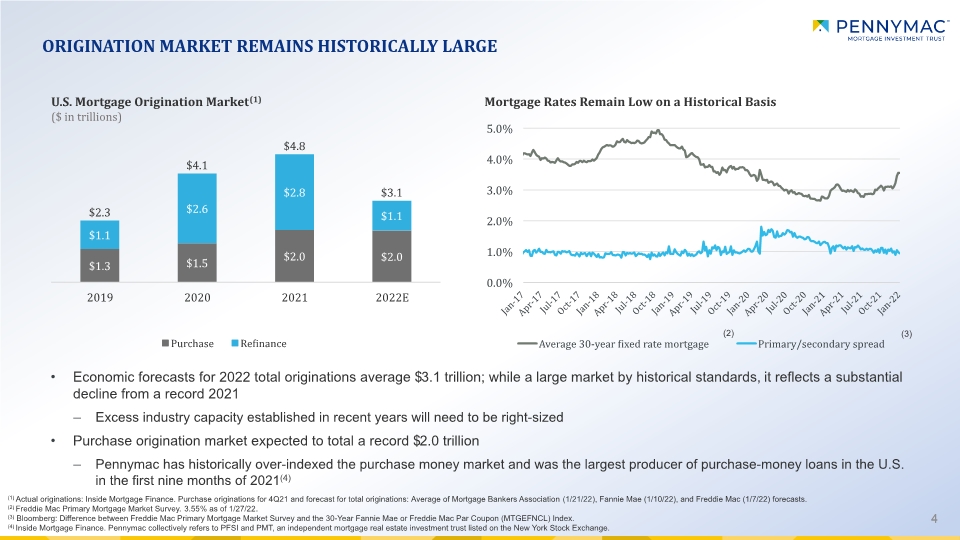
4 4 ORIGINATION MARKET REMAINS HISTORICALLY LARGE U.S. Mortgage Origination Market(1) ($ in trillions) Mortgage Rates Remain Low on a Historical Basis Economic forecasts for 2022 total originations average $3.1 trillion; while a large market by historical standards, it reflects a substantial decline from a record 2021 Excess industry capacity established in recent years will need to be right-sized Purchase origination market expected to total a record $2.0 trillion Pennymac has historically over-indexed the purchase money market and was the largest producer of purchase-money loans in the U.S. in the first nine months of 2021(4) (1) Actual originations: Inside Mortgage Finance. Purchase originations for 4Q21 and forecast for total originations: Average of Mortgage Bankers Association (1/21/22), Fannie Mae (1/10/22), and Freddie Mac (1/7/22) forecasts. (2) Freddie Mac Primary Mortgage Market Survey. 3.55% as of 1/27/22. (3) Bloomberg: Difference between Freddie Mac Primary Mortgage Market Survey and the 30-Year Fannie Mae or Freddie Mac Par Coupon (MTGEFNCL) Index. (4) Inside Mortgage Finance. Pennymac collectively refers to PFSI and PMT, an independent mortgage real estate investment trust listed on the New York Stock Exchange. (2) (3) U.S. Mortgage Origination Market(1) ($ in trillions) Mortgage Rates Remain Low on a Historical Basis $2.3 $1.1 $1.3 2019 $4.1 $2.6 $1.5 2020 $4.8 $2.8 $2.0 2021 $2.3 $1.1 $1.3 2022 0.0%1.0% 2.0% 3.0% 4.0% 5.0% Jan-17 Apr-17 Jul-17 Oct-17 Jan-18 Apr-18 Jul-18 Oct-18 Jan-19 Apr-19 Jul-19 Oct-19 Jan-20 Apr-20 Jul-20 Oct-20 Jan-21 Apr-21 Jul-21 Oct-21 Jan-22
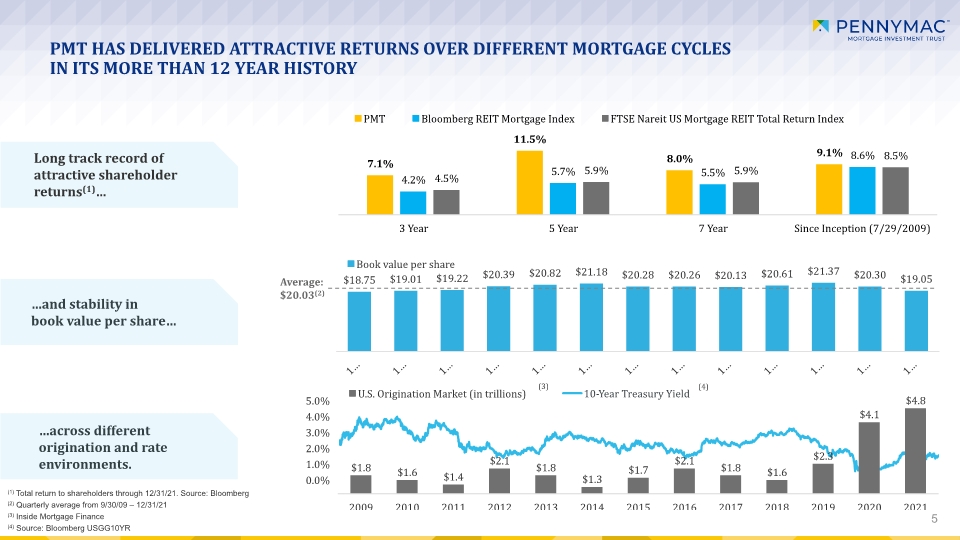
5 PMT HAS DELIVERED ATTRACTIVE RETURNS OVER DIFFERENT MORTGAGE CYCLES IN ITS MORE THAN 12 YEAR HISTORY Long track record of attractive shareholder returns(1)… …across different origination and rate environments. …and stability in book value per share… (1) Total return to shareholders through 12/31/21. Source: Bloomberg (2) Quarterly average from 9/30/09 – 12/31/21 (3) Inside Mortgage Finance (4) Source: Bloomberg USGG10YR (4) (3) Average: $20.03(2) PMT Bloomberg REIT Mortgage Index FTSE Nareit US Mortgage REIT Total Return Index 7.1% 11.5% 8.0% 9.1% 4.2% 5.7% 5.5% 8.6% 4.5% 5.9% 5.9% 8.5% 3 Year 5 Year 7 Year Since Inception (7/29/2009) Book value per share Average: $20.03(2) $18.75 $19.01 $19.22 $20.39 $20.82 $21.18 $20.28 $20.26 $20.13 $20.61 $21.37 $20.30 $19.05 12/31/09 12/31/10 12/31/11 12/31/12 12/31/13 12/31/14 12/31/15 12/31/16 12/31/17 12/31/18 12/31/19 12/31/20 12/31/21 U.S. Origination Market (in trillions) (3) 10-Year Treasury Yield (4) 0.0% 1.0% 2.0% 3.0% 4.0% 5.0% $1.8 $1.6 $1.4 $2.1 $1.8 $1.3 $1.7 $2.1 $1.8 $1.6 $2.3 $4.1 $4.8 2009 2010 2011 2012 2013 2014 2015 2016 2017 2018 2019 2020 2021
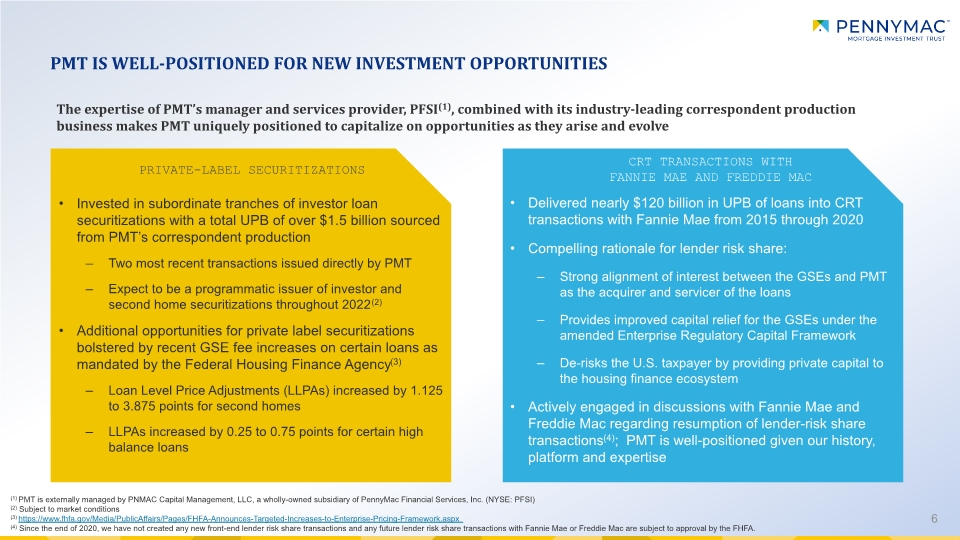
6 PMT IS WELL-POSITIONED FOR NEW INVESTMENT OPPORTUNITIES CRT TRANSACTIONS WITH FANNIE MAE AND FREDDIE MAC Private-label securitizations Invested in subordinate tranches of investor loan securitizations with a total UPB of over $1.5 billion sourced from PMT’s correspondent production Two most recent transactions issued directly by PMT Expect to be a programmatic issuer of investor and second home securitizations throughout 2022(2) Additional opportunities for private label securitizations bolstered by recent GSE fee increases on certain loans as mandated by the Federal Housing Finance Agency(3) Loan Level Price Adjustments (LLPAs) increased by 1.125 to 3.875 points for second homes LLPAs increased by 0.25 to 0.75 points for certain high balance loans Delivered nearly $120 billion in UPB of loans into CRT transactions with Fannie Mae from 2015 through 2020 Compelling rationale for lender risk share: Strong alignment of interest between the GSEs and PMT as the acquirer and servicer of the loans Provides improved capital relief for the GSEs under the amended Enterprise Regulatory Capital Framework De-risks the U.S. taxpayer by providing private capital to the housing finance ecosystem Actively engaged in discussions with Fannie Mae and Freddie Mac regarding resumption of lender-risk share transactions(4); PMT is well-positioned given our history, platform and expertise (1) PMT is externally managed by PNMAC Capital Management, LLC, a wholly-owned subsidiary of PennyMac Financial Services, Inc. (NYSE: PFSI) (2) Subject to market conditions (3) https://www.fhfa.gov/Media/PublicAffairs/Pages/FHFA-Announces-Targeted-Increases-to-Enterprise-Pricing-Framework.aspx (4) Since the end of 2020, we have not created any new front-end lender risk share transactions and any future lender risk share transactions with Fannie Mae or Freddie Mac are subject to approval by the FHFA. The expertise of PMT’s manager and services provider, PFSI(1), combined with its industry-leading correspondent production business makes PMT uniquely positioned to capitalize on opportunities as they arise and evolve
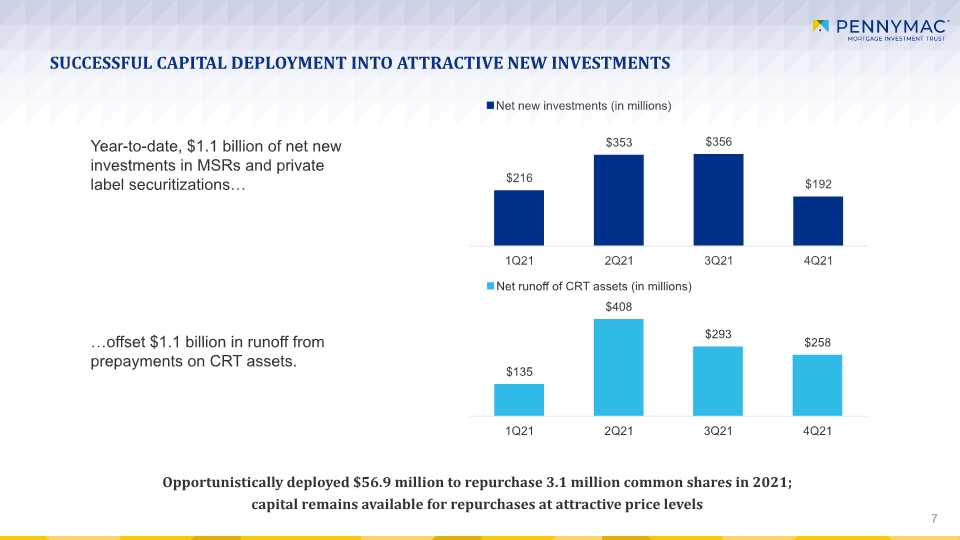
7 SUCCESSFUL CAPITAL DEPLOYMENT INTO ATTRACTIVE NEW INVESTMENTS Year-to-date, $1.1 billion of net new investments in MSRs and private label securitizations… …offset $1.1 billion in runoff from prepayments on CRT assets. Opportunistically deployed $56.9 million to repurchase 3.1 million common shares in 2021; capital remains available for repurchases at attractive price levels Net new investments (in millions) $216 $353 $356 $192 1Q21 2Q21 3Q21 4Q21 Net runoff of CRT assets (in millions) $135 $408 $293 $258 1Q21 2Q21 3Q21 4Q21
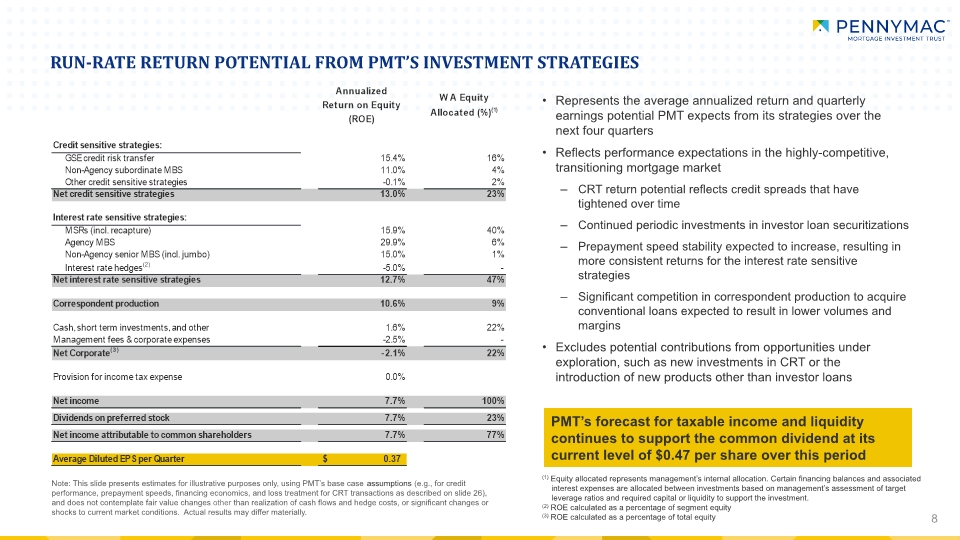
8 RUN-RATE RETURN POTENTIAL FROM PMT’S INVESTMENT STRATEGIES Note: This slide presents estimates for illustrative purposes only, using PMT’s base case assumptions (e.g., for credit performance, prepayment speeds, financing economics, and loss treatment for CRT transactions as described on slide 26), and does not contemplate fair value changes other than realization of cash flows and hedge costs, or significant changes or shocks to current market conditions. Actual results may differ materially. (1) Equity allocated represents management’s internal allocation. Certain financing balances and associated interest expenses are allocated between investments based on management’s assessment of target leverage ratios and required capital or liquidity to support the investment. (2) ROE calculated as a percentage of segment equity (3) ROE calculated as a percentage of total equity Represents the average annualized return and quarterly earnings potential PMT expects from its strategies over the next four quarters Reflects performance expectations in the highly-competitive, transitioning mortgage market CRT return potential reflects credit spreads that have tightened over time Continued periodic investments in investor loan securitizations Prepayment speed stability expected to increase, resulting in more consistent returns for the interest rate sensitive strategies Significant competition in correspondent production to acquire conventional loans expected to result in lower volumes and margins Excludes potential contributions from opportunities under exploration, such as new investments in CRT or the introduction of new products other than investor loans PMT’s forecast for taxable income and liquidity continues to support the common dividend at its current level of $0.47 per share over this period Annualized Return on Equity (ROE)WA Equity Allocated (%)(1)Credit sensitive strategies:GSE credit risk transfer15.4%16%Non-Agency subordinate MBS11.0%4%Other credit sensitive strategies-0.1%2%Net credit sensitive strategies13.0%23%Interest rate sensitive strategies:MSRs (incl. recapture)15.9%40%Agency MBS29.9%6%Non-Agency senior MBS (incl. jumbo)15.0%1%Interest rate hedges(2)-5.0%-Net interest rate sensitive strategies12.7%47%Correspondent production10.6%9%Cash, short term investments, and other1.6%22%Management fees & corporate expenses-2.5%-Net Corporate(3)-2.1%22%Provision for income tax expense0.0%Net income7.7%100%Dividends on preferred stock7.7%23%Net income attributable to common shareholders7.7%77%
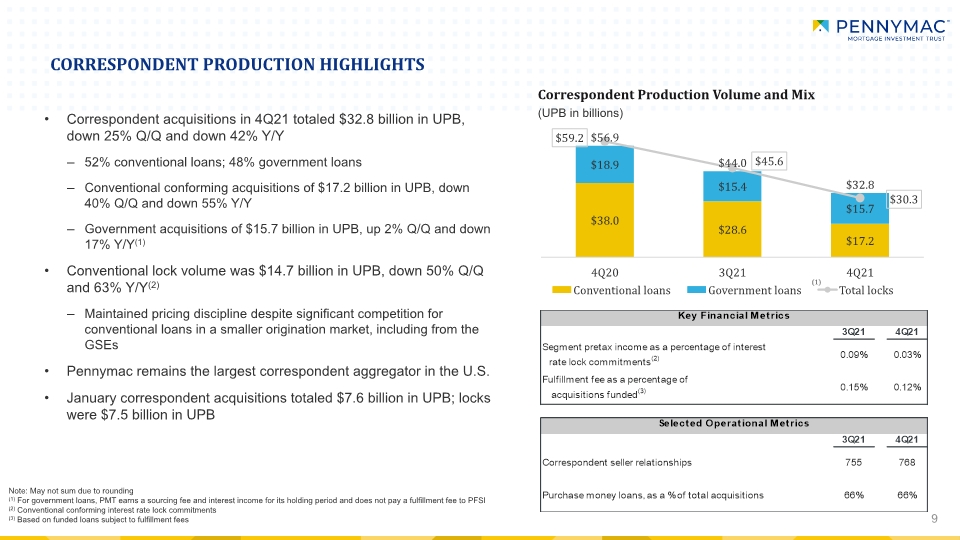
9 CORRESPONDENT PRODUCTION HIGHLIGHTS Note: May not sum due to rounding (1) For government loans, PMT earns a sourcing fee and interest income for its holding period and does not pay a fulfillment fee to PFSI (2) Conventional conforming interest rate lock commitments (3) Based on funded loans subject to fulfillment fees (1) Correspondent acquisitions in 4Q21 totaled $32.8 billion in UPB, down 25% Q/Q and down 42% Y/Y 52% conventional loans; 48% government loans Conventional conforming acquisitions of $17.2 billion in UPB, down 40% Q/Q and down 55% Y/Y Government acquisitions of $15.7 billion in UPB, up 2% Q/Q and down 17% Y/Y(1) Conventional lock volume was $14.7 billion in UPB, down 50% Q/Q and 63% Y/Y(2) Maintained pricing discipline despite significant competition for conventional loans in a smaller origination market, including from the GSEs Pennymac remains the largest correspondent aggregator in the U.S. January correspondent acquisitions totaled $7.6 billion in UPB; locks were $7.5 billion in UPB Correspondent Production Volume and Mix (UPB in billions) Correspondent Production Volume and Mix (UPB in billions) $59.2 $38.0 $28.6 $17.2 $18.9 $15.4 $15.7 $56.9 $44.0 $32.8 $45.6 $30.3 4Q20 3Q21 4Q21 Conventional loans Government loans Total locks Key Financial Metrics 3Q214Q21Segment pretax income as a percentage of interest rate lock commitments(2)0.09%0.03%Fulfillment fee as a percentage of acquisitions funded(3)0.15%0.12% Selected Operational Metrics 3Q214Q21Correspondent seller relationships755768Purchase money loans, as a % of total acquisitions66%66%
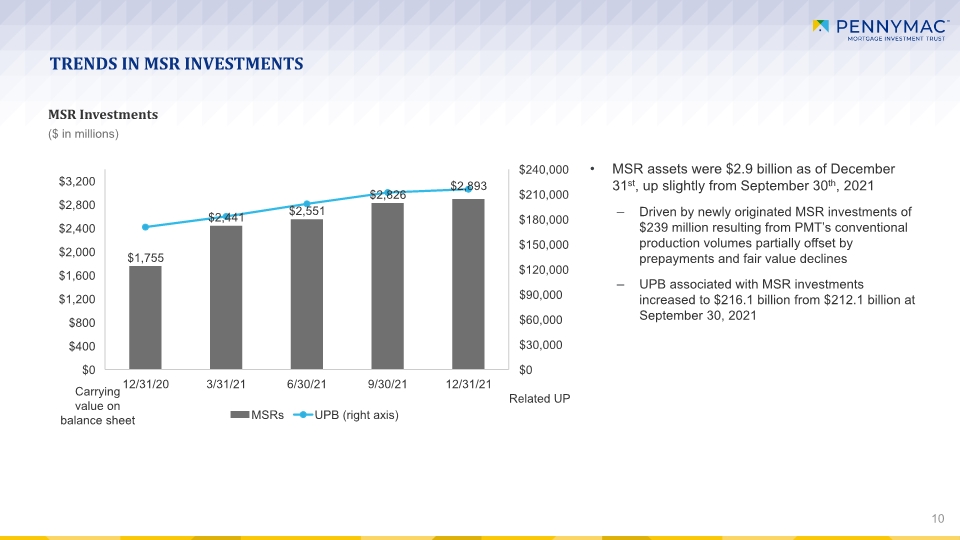
10 TRENDS IN MSR INVESTMENTS MSR assets were $2.9 billion as of December 31st, up slightly from September 30th, 2021 Driven by newly originated MSR investments of $239 million resulting from PMT’s conventional production volumes partially offset by prepayments and fair value declines UPB associated with MSR investments increased to $216.1 billion from $212.1 billion at September 30, 2021 MSR Investments ($ in millions) MSR Investments ($ in millions) $2,893 $1,755 $2,441 $2,551 $2,826 $0 $30,000 $60,000 $90,000 $120,000 $150,000 $180,000 $210,000 $240,000 $0 $400 $800 $1,200 $1,600 $2,000 $2,400 $2,800 $3,200 12/31/20 3/31/21 6/30/21 9/30/21 12/31/21 Related UPB Carrying value on balance sheet MSRs UPB (right axis)
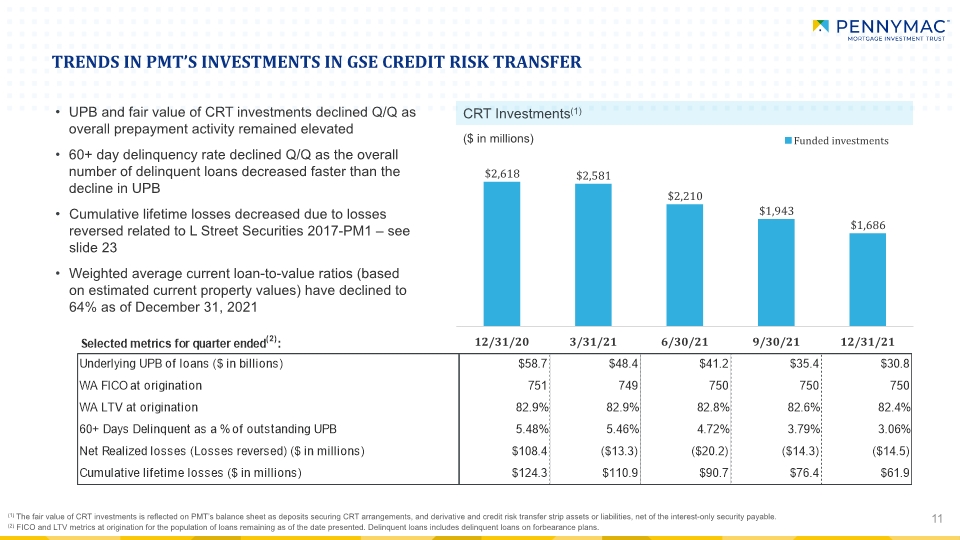
11 TRENDS IN PMT’S INVESTMENTS IN GSE CREDIT RISK TRANSFER UPB and fair value of CRT investments declined Q/Q as overall prepayment activity remained elevated 60+ day delinquency rate declined Q/Q as the overall number of delinquent loans decreased faster than the decline in UPB Cumulative lifetime losses decreased due to losses reversed related to L Street Securities 2017-PM1 – see slide 23 Weighted average current loan-to-value ratios (based on estimated current property values) have declined to 64% as of December 31, 2021 (1) The fair value of CRT investments is reflected on PMT’s balance sheet as deposits securing CRT arrangements, and derivative and credit risk transfer strip assets or liabilities, net of the interest-only security payable. (2) FICO and LTV metrics at origination for the population of loans remaining as of the date presented. Delinquent loans includes delinquent loans on forbearance plans. CRT Investments(1) ($ in millions) CRT Investments (1) Funded investments ($ in millions) $2,618 $2,581 $2,210 $1,943 $1,686 12/31/20 3/31/21 6/30/21 9/30/21 12/31/21 Selected metrics for quarter ended(2):Underlying UPB of loans ($ in billions)$58.7$48.4$41.2$35.4$30.8WA FICO at origination751749750750750WA LTV at origination82.9%82.9%82.8%82.6%82.4%60+ Days Delinquent as a % of outstanding UPB5.48%5.46%4.72%3.79%3.06%Net Realized losses (Losses reversed) ($ in millions)$108.4($13.3)($20.2)($14.3)($14.5)Cumulative lifetime losses ($ in millions)$124.3$110.9$90.7$76.4$61.9
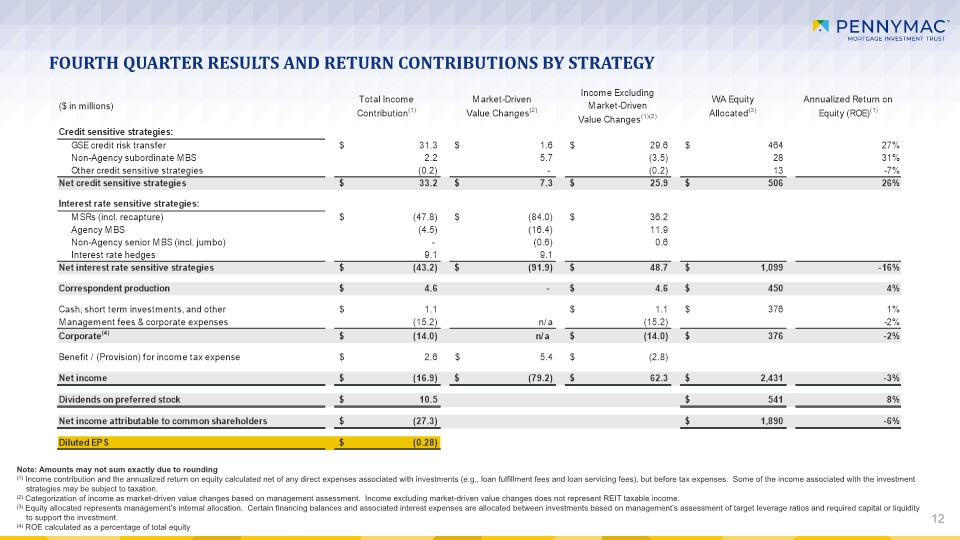
12 FOURTH QUARTER RESULTS AND RETURN CONTRIBUTIONS BY STRATEGY Note: Amounts may not sum exactly due to rounding (1) Income contribution and the annualized return on equity calculated net of any direct expenses associated with investments (e.g., loan fulfillment fees and loan servicing fees), but before tax expenses. Some of the income associated with the investment strategies may be subject to taxation. (2) Categorization of income as market-driven value changes based on management assessment. Income excluding market-driven value changes does not represent REIT taxable income. (3) Equity allocated represents management’s internal allocation. Certain financing balances and associated interest expenses are allocated between investments based on management’s assessment of target leverage ratios and required capital or liquidity to support the investment. (4) ROE calculated as a percentage of total equity $ in millions)Total Income Contribution(1)Market-Driven Value Changes(2)Income Excluding Market-Driven Value Changes(1)(2)WA EquityAllocated(3)Annualized Return on Equity (ROE)(1)Credit sensitive strategies:GSE credit risk transfer31.3$ 1.6$ 29.6$ 464$ 27%Non-Agency subordinate MBS2.2 5.7 (3.5) 28 31%Other credit sensitive strategies(0.2) - (0.2) 13 -7%Net credit sensitive strategies33.2$ 7.3$ 25.9$ 506$ 26%Interest rate sensitive strategies:MSRs (incl. recapture)(47.8)$ (84.0)$ 36.2$ Agency MBS(4.5) (16.4) 11.9 Non-Agency senior MBS (incl. jumbo)- (0.6) 0.6 Interest rate hedges9.1 9.1 Net interest rate sensitive strategies(43.2)$ (91.9)$ 48.7$ 1,099$ -16%Correspondent production4.6$ -4.6$ 450$ 4%Cash, short term investments, and other1.1$ 1.1$ 376$ 1%Management fees & corporate expenses(15.2) n/a(15.2) -2%Corporate(4)(14.0)$ n/a(14.0)$ 376$ -2%Benefit / (Provision) for income tax expense2.6$ 5.4$ (2.8)$ Net income(16.9)$ (79.2)$ 62.3$ 2,431$ -3%Dividends on preferred stock10.5$ 541$ 8%Net income attributable to common shareholders(27.3)$ 1,890$ -6%Diluted EPS(0.28)
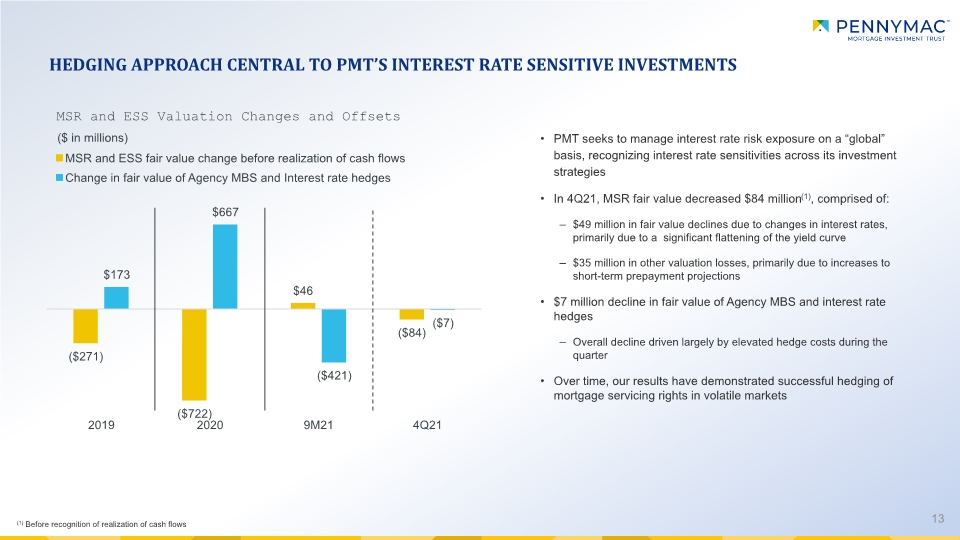
13 HEDGING APPROACH CENTRAL TO PMT’S INTEREST RATE SENSITIVE INVESTMENTS PMT seeks to manage interest rate risk exposure on a “global” basis, recognizing interest rate sensitivities across its investment strategies In 4Q21, MSR fair value decreased $84 million(1), comprised of: $49 million in fair value declines due to changes in interest rates, primarily due to a significant flattening of the yield curve $35 million in other valuation losses, primarily due to increases to short-term prepayment projections $7 million decline in fair value of Agency MBS and interest rate hedges Overall decline driven largely by elevated hedge costs during the quarter Over time, our results have demonstrated successful hedging of mortgage servicing rights in volatile markets MSR and ESS Valuation Changes and Offsets ($ in millions) (1) Before recognition of realization of cash flows

APPENDIX
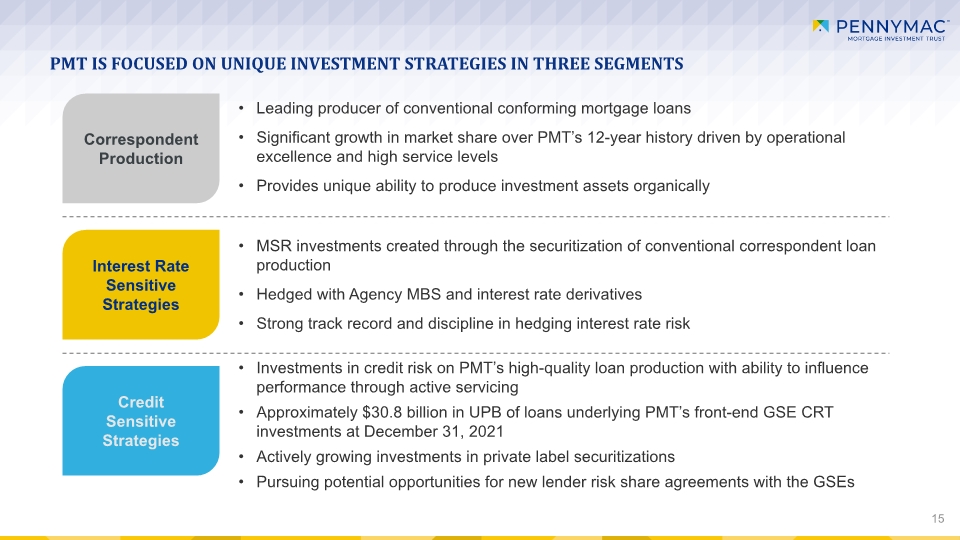
15 PMT IS FOCUSED ON UNIQUE INVESTMENT STRATEGIES IN THREE SEGMENTS Leading producer of conventional conforming mortgage loans Significant growth in market share over PMT’s 12-year history driven by operational excellence and high service levels Provides unique ability to produce investment assets organically Investments in credit risk on PMT’s high-quality loan production with ability to influence performance through active servicing Approximately $30.8 billion in UPB of loans underlying PMT’s front-end GSE CRT investments at December 31, 2021 Actively growing investments in private label securitizations Pursuing potential opportunities for new lender risk share agreements with the GSEs MSR investments created through the securitization of conventional correspondent loan production Hedged with Agency MBS and interest rate derivatives Strong track record and discipline in hedging interest rate risk Correspondent Production Interest Rate Sensitive Strategies Credit Sensitive Strategies
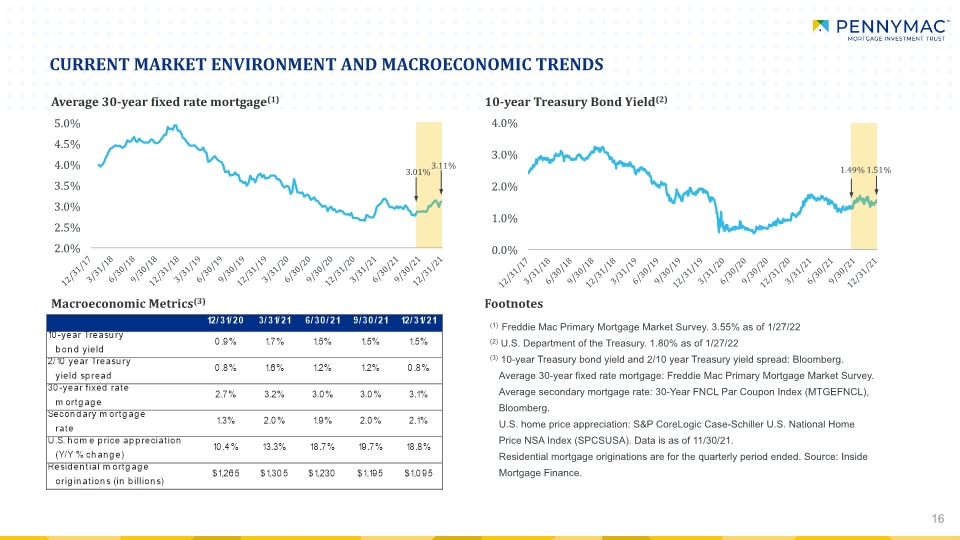
16 CURRENT MARKET ENVIRONMENT AND MACROECONOMIC TRENDS Average 30-year fixed rate mortgage(1) 10-year Treasury Bond Yield(2) Macroeconomic Metrics(3) Footnotes 1.51% 1.49% 3.11% 3.01% (1) Freddie Mac Primary Mortgage Market Survey. 3.55% as of 1/27/22 (2) U.S. Department of the Treasury. 1.80% as of 1/27/22 (3) 10-year Treasury bond yield and 2/10 year Treasury yield spread: Bloomberg. Average 30-year fixed rate mortgage: Freddie Mac Primary Mortgage Market Survey. Average secondary mortgage rate: 30-Year FNCL Par Coupon Index (MTGEFNCL), Bloomberg. U.S. home price appreciation: S&P CoreLogic Case-Schiller U.S. National Home Price NSA Index (SPCSUSA). Data is as of 11/30/21. Residential mortgage originations are for the quarterly period ended. Source: Inside Mortgage Finance. Macroeconomic Metrics ( 12/31/203/31/216/30/219/30/2112/31/2110-year Treasury bond yield0.9%1.7%1.5%1.5%1.5%2/10 year Treasury yield spread0.8%1.6%1.2%1.2%0.8%30-year fixed rate mortgage2.7%3.2%3.0%3.0%3.1%Secondary mortgage rate1.3%2.0%1.9%2.0%2.1%U.S. home price appreciation (Y/Y % change)10.4%13.3%18.7%19.7%18.8%Residential mortgage originations (in billions)$1,265$1,305$1,230$1,195$1,095
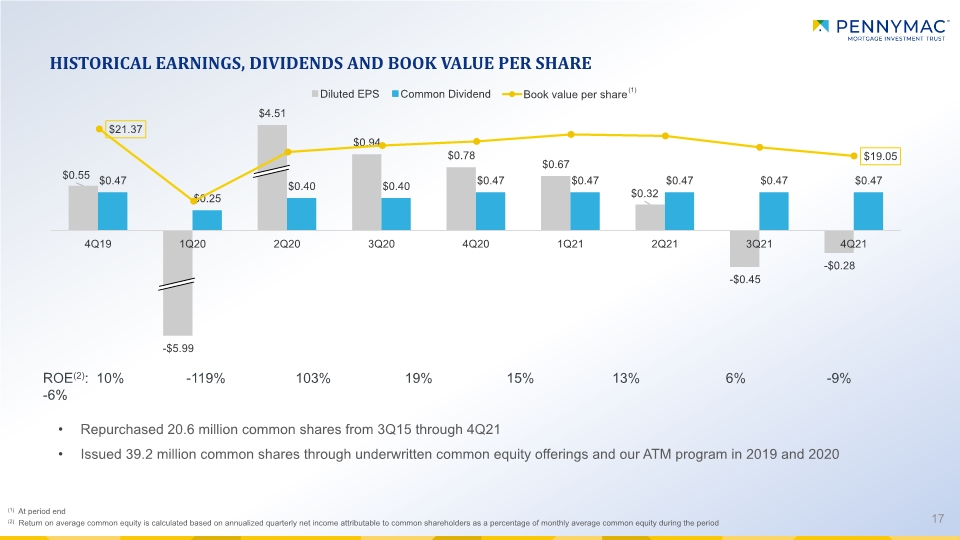
17 HISTORICAL EARNINGS, DIVIDENDS AND BOOK VALUE PER SHARE Repurchased 20.6 million common shares from 3Q15 through 4Q21 Issued 39.2 million common shares through underwritten common equity offerings and our ATM program in 2019 and 2020 (1) (1) At period end (2) Return on average common equity is calculated based on annualized quarterly net income attributable to common shareholders as a percentage of monthly average common equity during the period ROE(2): 10% -119% 103% 19% 15% 13% 6% -9% -6%
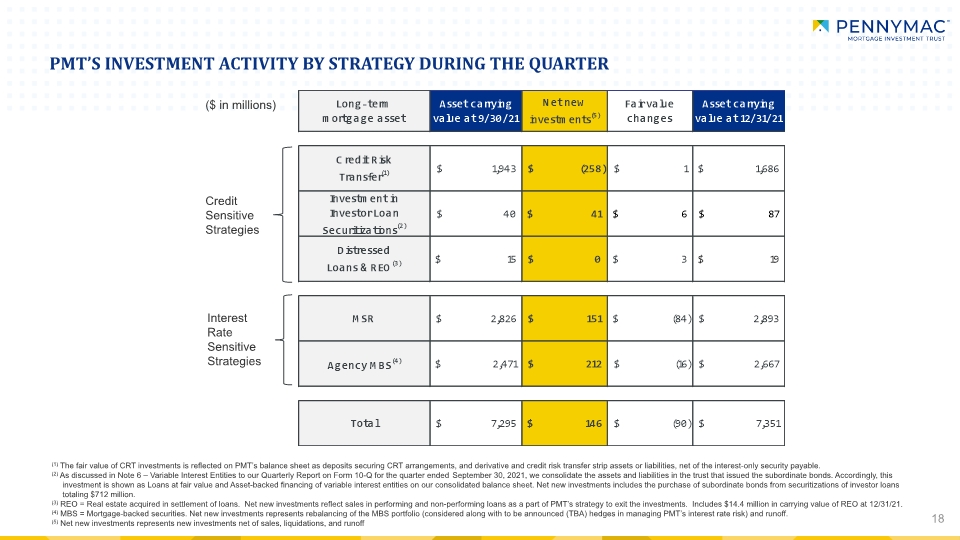
18 PMT’S INVESTMENT ACTIVITY BY STRATEGY DURING THE QUARTER Credit Sensitive Strategies Interest Rate Sensitive Strategies ($ in millions) (1) The fair value of CRT investments is reflected on PMT’s balance sheet as deposits securing CRT arrangements, and derivative and credit risk transfer strip assets or liabilities, net of the interest-only security payable. (2) As discussed in Note 6 – Variable Interest Entities to our Quarterly Report on Form 10-Q for the quarter ended September 30, 2021, we consolidate the assets and liabilities in the trust that issued the subordinate bonds. Accordingly, this investment is shown as Loans at fair value and Asset-backed financing of variable interest entities on our consolidated balance sheet. Net new investments includes the purchase of subordinate bonds from securitizations of investor loans totaling $712 million. (3) REO = Real estate acquired in settlement of loans. Net new investments reflect sales in performing and non-performing loans as a part of PMT’s strategy to exit the investments. Includes $14.4 million in carrying value of REO at 12/31/21. (4) MBS = Mortgage-backed securities. Net new investments represents rebalancing of the MBS portfolio (considered along with to be announced (TBA) hedges in managing PMT’s interest rate risk) and runoff. (5) Net new investments represents new investments net of sales, liquidations, and runoff ($ in millions) Credit Sensitive Strategies Interest Rate Sensitive Strategies Long-term mortgage assetAsset carrying value at 9/30/21Net new investments(5)Fair value changesAsset carrying value at 12/31/21Credit Risk Transfer(1)1,943$ (258)$ 1$ 1,686$ Investment in Investor Loan Securitizations(2)40$ 41$ 6$ 87$ Distressed Loans & REO(3)15$ 0$ 3$ 19$ MSR 2,826$ 151$ (84)$ 2,893$ Agency MBS(4)2,471$ 212$ (16)$ 2,667$ Total7,295$ 146$ (90)$ 7,351$
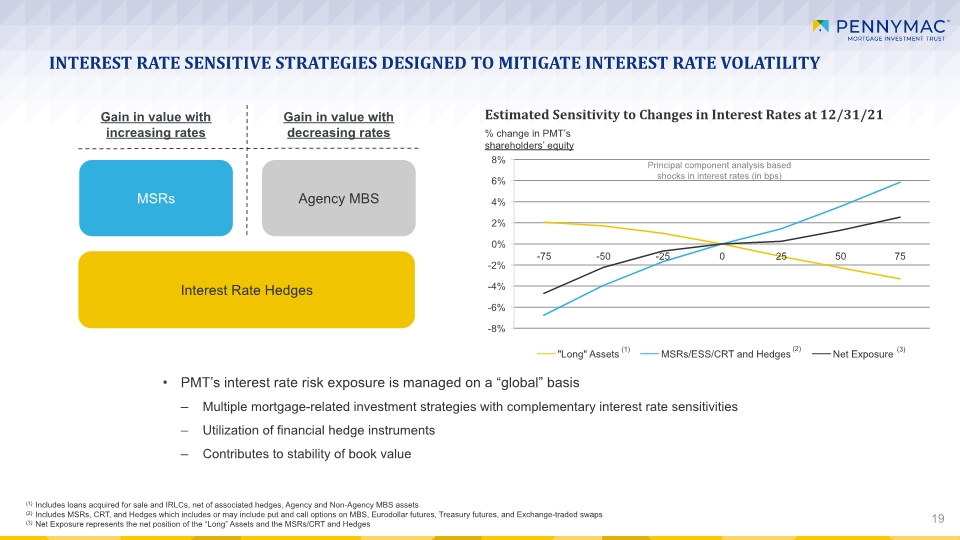
19 INTEREST RATE SENSITIVE STRATEGIES DESIGNED TO MITIGATE INTEREST RATE VOLATILITY Estimated Sensitivity to Changes in Interest Rates at 12/31/21 % change in PMT���s shareholders’ equity PMT’s interest rate risk exposure is managed on a “global” basis Multiple mortgage-related investment strategies with complementary interest rate sensitivities Utilization of financial hedge instruments Contributes to stability of book value (1) Includes loans acquired for sale and IRLCs, net of associated hedges, Agency and Non-Agency MBS assets (2) Includes MSRs, CRT, and Hedges which includes or may include put and call options on MBS, Eurodollar futures, Treasury futures, and Exchange-traded swaps (3) Net Exposure represents the net position of the “Long” Assets and the MSRs/CRT and Hedges Principal component analysis based shocks in interest rates (in bps) (1) (2) (3) Gain in value with increasing rates Gain in value with decreasing rates MSRs Agency MBS Interest Rate Hedges
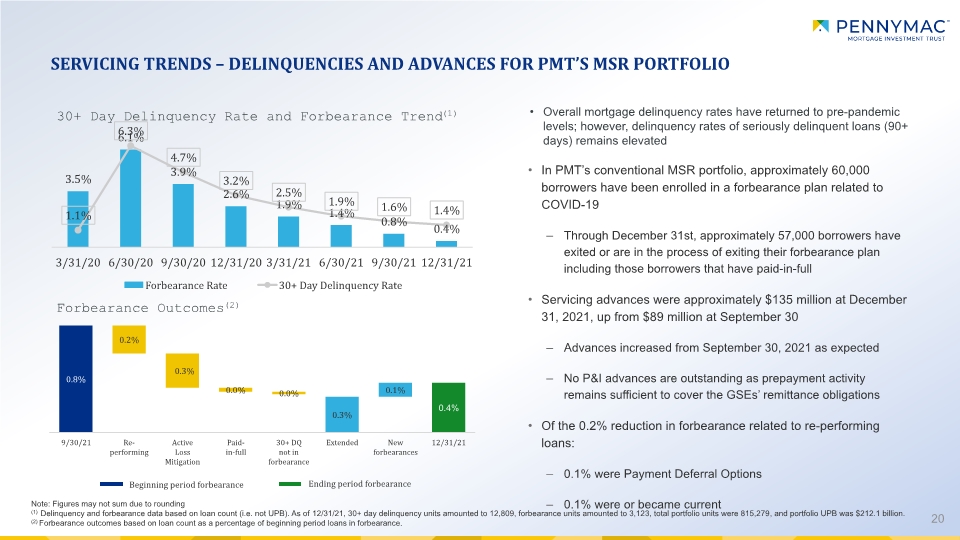
20 SERVICING TRENDS – DELINQUENCIES AND ADVANCES FOR PMT’S MSR PORTFOLIO Overall mortgage delinquency rates have returned to pre-pandemic levels; however, delinquency rates of seriously delinquent loans (90+ days) remains elevated In PMT’s conventional MSR portfolio, approximately 60,000 borrowers have been enrolled in a forbearance plan related to COVID-19 Through December 31st, approximately 57,000 borrowers have exited or are in the process of exiting their forbearance plan including those borrowers that have paid-in-full Servicing advances were approximately $135 million at December 31, 2021, up from $89 million at September 30 Advances increased from September 30, 2021 as expected No P&I advances are outstanding as prepayment activity remains sufficient to cover the GSEs’ remittance obligations Of the 0.2% reduction in forbearance related to re-performing loans: 0.1% were Payment Deferral Options 0.1% were or became current 30+ Day Delinquency Rate and Forbearance Trend(1) Note: Figures may not sum due to rounding (1) Delinquency and forbearance data based on loan count (i.e. not UPB). As of 12/31/21, 30+ day delinquency units amounted to 12,809, forbearance units amounted to 3,123, total portfolio units were 815,279, and portfolio UPB was $212.1 billion. (2) Forbearance outcomes based on loan count as a percentage of beginning period loans in forbearance. Forbearance Outcomes(2) Ending period forbearance Beginning period forbearance
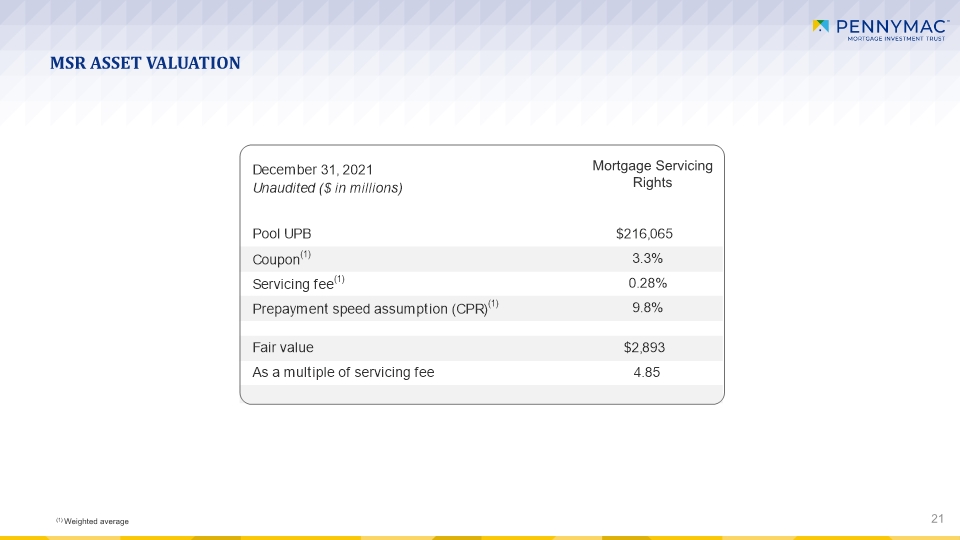
21 MSR ASSET VALUATION Mortgage Servicing Rights (1) Weighted average Mortgage Servicing Rights (1) Pool UPB $216,065 Coupon (1) 3.3% Servicing fee (1) 0.28% Prepayment speed assumption (CPR)(1) 9.8% Fair value $2,893 As a multiple of servicing fee 4.85 December 31, 2021 Unaudited ($ in millions)
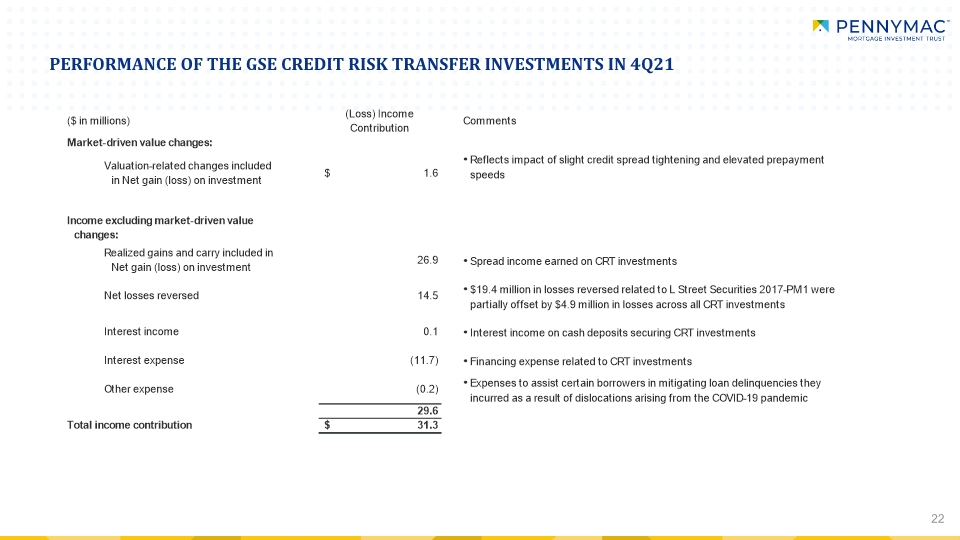
22 PERFORMANCE OF THE GSE CREDIT RISK TRANSFER INVESTMENTS IN 4Q21 ($ in millions)(Loss) IncomeContributionCommentsMarket-driven value changes:Valuation-related changes included in Net gain (loss) on investment1.6$ • Reflects impact of slight credit spread tightening and elevated prepayment speedsRealized gains and carry included in Net gain (loss) on investment26.9 • Spread income earned on CRT investmentsNet losses reversed14.5 • $19.4 million in losses reversed related to L Street Securities 2017-PM1 were partially offset by $4.9 million in losses across all CRT investmentsInterest income0.1 • Interest income on cash deposits securing CRT investmentsInterest expense(11.7) • Financing expense related to CRT investmentsOther expense(0.2) • Expenses to assist certain borrowers in mitigating loan delinquencies they incurred as a result of dislocations arising from the COVID-19 pandemic29.6 Total income contribution31.3$ Income excluding market-driven value changes:
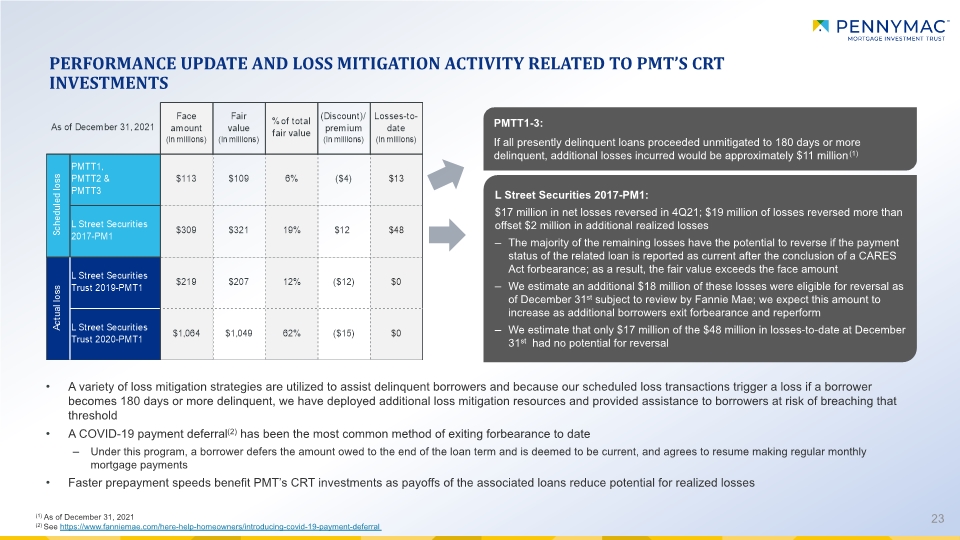
23 PERFORMANCE UPDATE AND LOSS MITIGATION ACTIVITY RELATED TO PMT’S CRT INVESTMENTS A variety of loss mitigation strategies are utilized to assist delinquent borrowers and because our scheduled loss transactions trigger a loss if a borrower becomes 180 days or more delinquent, we have deployed additional loss mitigation resources and provided assistance to borrowers at risk of breaching that threshold A COVID-19 payment deferral(2) has been the most common method of exiting forbearance to date Under this program, a borrower defers the amount owed to the end of the loan term and is deemed to be current, and agrees to resume making regular monthly mortgage payments Faster prepayment speeds benefit PMT’s CRT investments as payoffs of the associated loans reduce potential for realized losses (1) As of December 31, 2021 (2) See https://www.fanniemae.com/here-help-homeowners/introducing-covid-19-payment-deferral PMTT1-3: If all presently delinquent loans proceeded unmitigated to 180 days or more delinquent, additional losses incurred would be approximately $11 million(1) L Street Securities 2017-PM1: $17 million in net losses reversed in 4Q21; $19 million of losses reversed more than offset $2 million in additional realized losses The majority of the remaining losses have the potential to reverse if the payment status of the related loan is reported as current after the conclusion of a CARES Act forbearance; as a result, the fair value exceeds the face amount We estimate an additional $18 million of these losses were eligible for reversal as of December 31st subject to review by Fannie Mae; we expect this amount to increase as additional borrowers exit forbearance and reperform We estimate that only $17 million of the $48 million in losses-to-date at December 31st had no potential for reversal as of December 31, 2021 Scheduled LOSS Actual loss Face amount(in millions)Fair value(in millions)% of total fair value(Discount)/premium(in millions)Losses-to-date(in millions)PMTT1, PMTT2 & PMTT3$113$1096%($4)$13L Street Securities 2017-PM1$309$32119%$12$48L Street Securities Trust 2019-PMT1$219$20712%($12)$0L Street Securities Trust 2020-PMT1$1,064$1,04962%($15)$0As
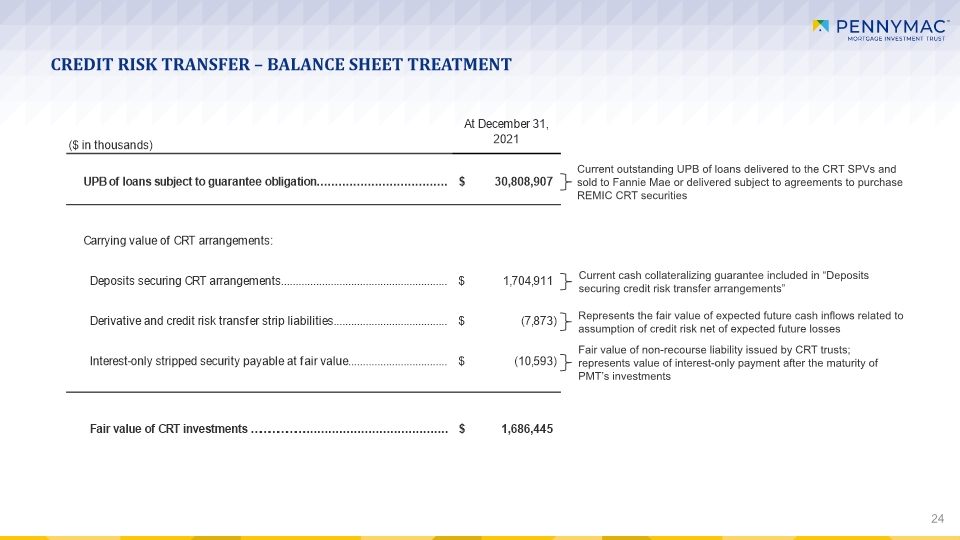
24 CREDIT RISK TRANSFER – BALANCE SHEET TREATMENT Current outstanding UPB of loans delivered to the CRT SPVs and sold to Fannie Mae or delivered subject to agreements to purchase REMIC CRT securities Current cash collateralizing guarantee included in “Deposits securing credit risk transfer arrangements” Represents the fair value of expected future cash inflows related to assumption of credit risk net of expected future losses Fair value of non-recourse liability issued by CRT trusts; represents value of interest-only payment after the maturity of PMT’s investments ($ in thousands)At December 31, 2021UPB of loans subject to guarantee obligation 30,808,907$ Carrying value of CRT arrangements:Deposits securing CRT arrangements 1,704,911$ Derivative and credit risk transfer strip liabilities (7,873)$ Interest-only stripped security payable at fair value (10,593)$ Fair value of CRT investments 1,686,445
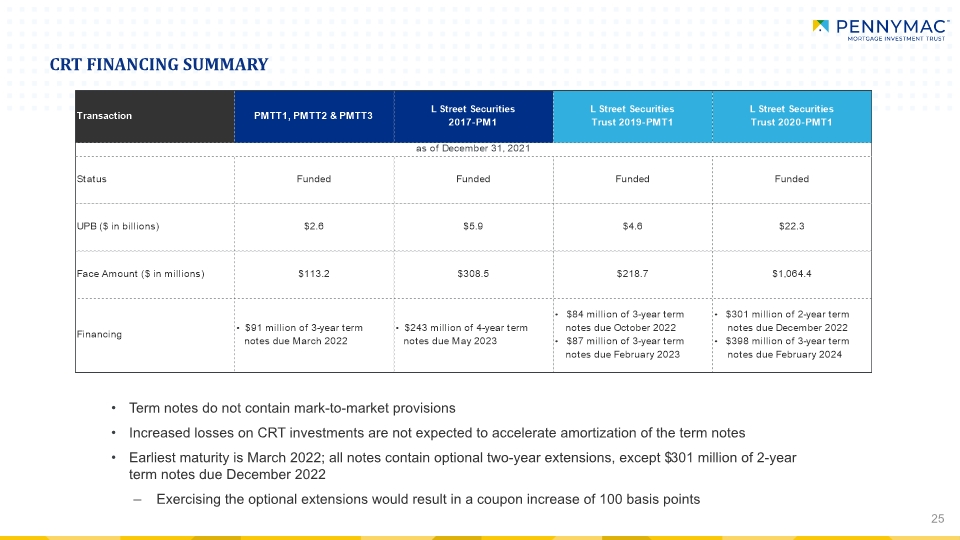
25 CRT FINANCING SUMMARY Term notes do not contain mark-to-market provisions Increased losses on CRT investments are not expected to accelerate amortization of the term notes Earliest maturity is March 2022; all notes contain optional two-year extensions, except $301 million of 2-year term notes due December 2022 Exercising the optional extensions would result in a coupon increase of 100 basis points TransactionPMTT1, PMTT2 & PMTT3L Street Securities2017-PM1L Street SecuritiesTrust 2019-PMT1L Street SecuritiesTrust 2020-PMT1as of December 31, 2021 StatusFundedFundedFundedFundedUPB ($ in billions)$2.6$5.9$4.6$22.3Face Amount ($ in millions)$113.2$308.5$218.7$1,064.4Financing• $91 million of 3-year term notes due March 2022• $243 million of 4-year term notes due May 2023• $84 million of 3-year term notes due October 2022• $87 million of 3-year term notes due February 2023• $301 million of 2-year term notes due December 2022• $398 million of 3-year term notes due February 2024as
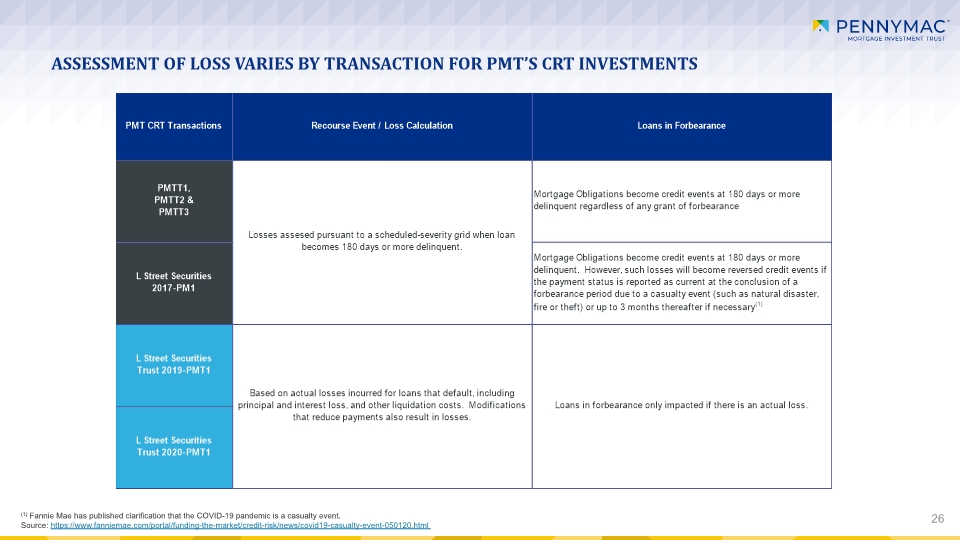
26 ASSESSMENT OF LOSS VARIES BY TRANSACTION FOR PMT’S CRT INVESTMENTS (1) Fannie Mae has published clarification that the COVID-19 pandemic is a casualty event. Source: https://www.fanniemae.com/portal/funding-the-market/credit-risk/news/covid19-casualty-event-050120.html PMT CRT TransactionsRecourse Event / Loss CalculationLoans in ForbearancePMTT1, PMTT2 & PMTT3Mortgage Obligations become credit events at 180 days or more delinquent regardless of any grant of forbearanceL Street Securities2017-PM1Mortgage Obligations become credit events at 180 days or more delinquent. However, such losses will become reversed credit events if the payment status is reported as current at the conclusion of a forbearance period due to a casualty event (such as natural disaster, fire or theft) or up to 3 months thereafter if necessary(1)L Street SecuritiesTrust 2019-PMT1L Street SecuritiesTrust 2020-PMT1Losses assesed pursuant to a scheduled-severity grid when loan becomes 180 days or more delinquent.Based on actual losses incurred for loans that default, including principal and interest loss, and other liquidation costs. Modifications that reduce payments also result in losses.Loans in forbearance only impacted if there is an actual loss.
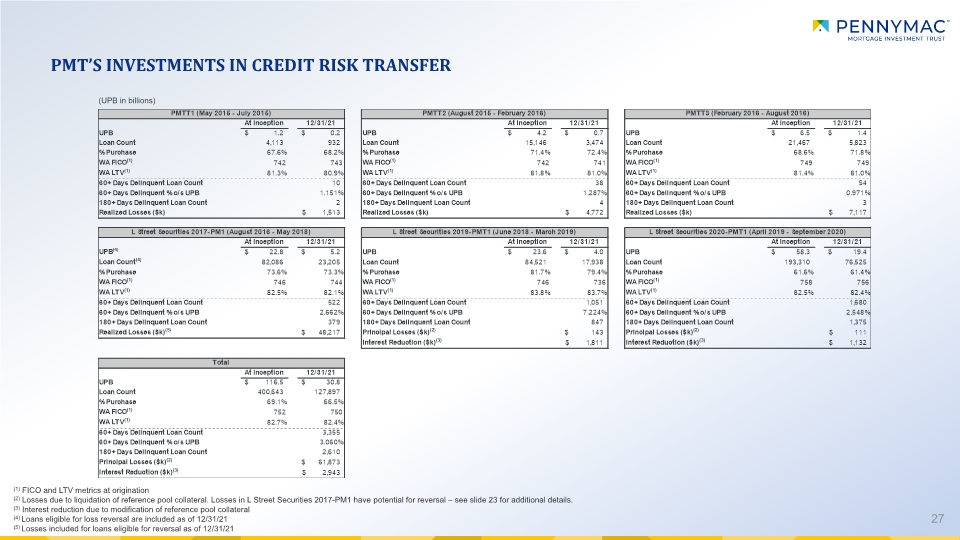
27 PMT’S INVESTMENTS IN CREDIT RISK TRANSFER (1) FICO and LTV metrics at origination (2) Losses due to liquidation of reference pool collateral. Losses in L Street Securities 2017-PM1 have potential for reversal – see slide 23 for additional details. (3) Interest reduction due to modification of reference pool collateral (4) Loans eligible for loss reversal are included as of 12/31/21 (5) Losses included for loans eligible for reversal as of 12/31/21 (UPB in billions) (UPB in billions) PMTT1 (May 2015 - July 2015)PMTT2 (August 2015 - February 2016)PMTT3 (February 2016 - August 2016)At inception12/31/21At inception12/31/21At inception12/31/21UPB1.2$ 0.2$ UPB4.2$ 0.7$ UPB6.5$ 1.4$ Loan Count4,113 932 Loan Count15,146 3,474 Loan Count21,467 5,823 % Purchase67.6%68.2%% Purchase71.4%72.4%% Purchase68.6%71.8%WA FICO(1)742743WA FICO(1)742741WA FICO(1)749749WA LTV(1)81.3%80.9%WA LTV(1)81.8%81.0%WA LTV(1)81.4%81.0%60+ Days Delinquent Loan Count10 60+ Days Delinquent Loan Count38 60+ Days Delinquent Loan Count54 60+ Days Delinquent % o/s UPB1.151%60+ Days Delinquent % o/s UPB1.287%60+ Days Delinquent % o/s UPB0.971%180+ Days Delinquent Loan Count2 180+ Days Delinquent Loan Count4 180+ Days Delinquent Loan Count3 Realized Losses ($k)1,513$ Realized Losses ($k)4,772$ Realized Losses ($k)7,117$ L Street Securities 2017-PM1 (August 2016 - May 2018)L Street Securities 2019-PMT1 (June 2018 - March 2019)L Street Securities 2020-PMT1 (April 2019 - September 2020)At inception12/31/21At inception12/31/21At inception12/31/21UPB(4)22.8$ 5.2$ UPB23.6$ 4.0$ UPB58.3$ 19.4$ Loan Count(4)82,086 23,205 Loan Count84,521 17,938 Loan Count193,310 76,525 % Purchase73.6%73.3%% Purchase81.7%79.4%% Purchase61.6%61.4%WA FICO(1)746744WA FICO(1)746736WA FICO(1)758756WA LTV(1)82.5%82.1%WA LTV(1)83.8%83.7%WA LTV(1)82.5%82.4%60+ Days Delinquent Loan Count522 60+ Days Delinquent Loan Count1,051 60+ Days Delinquent Loan Count1,680 60+ Days Delinquent % o/s UPB2.662%60+ Days Delinquent % o/s UPB7.224%60+ Days Delinquent % o/s UPB2.548%180+ Days Delinquent Loan Count379 180+ Days Delinquent Loan Count847 180+ Days Delinquent Loan Count1,375 Realized Losses ($k)(5)48,217$ Principal Losses ($k)(2)143$ Principal Losses ($k)(2)111$ Interest Reduction ($k)(3)1,811$ Interest Reduction ($k)(3)1,132$ TotalAt inception12/31/21UPB116.5$ 30.8$ Loan Count400,643 127,897 % Purchase69.1%66.5%WA FICO(1)752750WA LTV(1)82.7%82.4%60+ Days Delinquent Loan Count3,355 60+ Days Delinquent % o/s UPB3.060%180+ Days Delinquent Loan Count2,610 Principal Losses ($k)(2)61,873$ Interest Reduction ($k)(3)2,943$
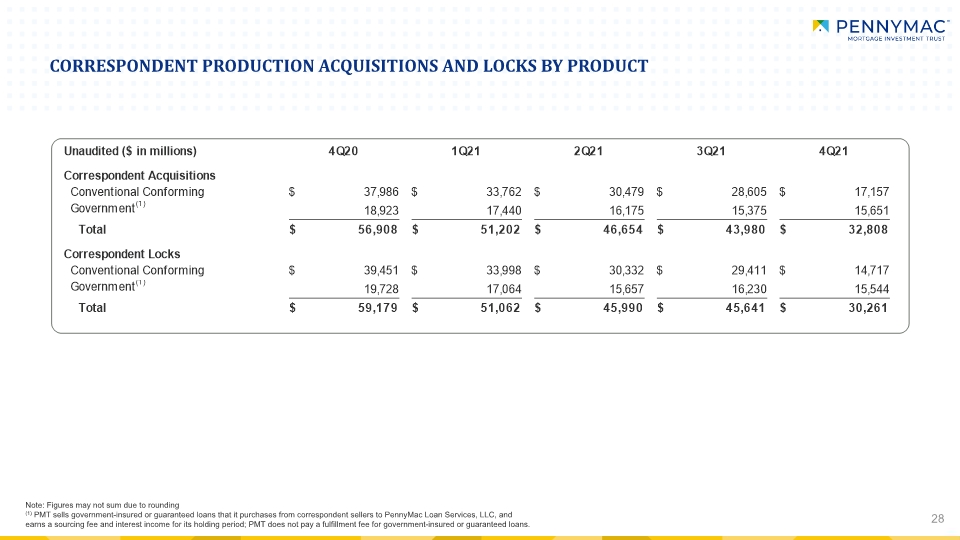
28 CORRESPONDENT PRODUCTION ACQUISITIONS AND LOCKS BY PRODUCT Note: Figures may not sum due to rounding (1) PMT sells government-insured or guaranteed loans that it purchases from correspondent sellers to PennyMac Loan Services, LLC, and earns a sourcing fee and interest income for its holding period; PMT does not pay a fulfillment fee for government-insured or guaranteed loans. Unaudited ($ in millions) 4Q20 1Q21 2Q21 3Q21 4Q21 Correspondent Acquisitions Conventional Conforming $ 37,986 $ 33,762 $ 30,479 $ 28,605 $ 17,157 Government(1) 18,923 17,440 16,175 15,375 15,651 Total $ 56,908 $ 51,202 $ 46,654 $ 43,980 $ 32,808 Correspondent Locks Conventional Conforming $ 39,451 $ 33,998 $ 30,332 $ 29,411 $ 14,717 Government(1) 19,728 17,064 15,657 16,230 15,544 Total $ 59,179 $ 51,062 $ 45,990 $ 45,641 $ 30,261

29




























